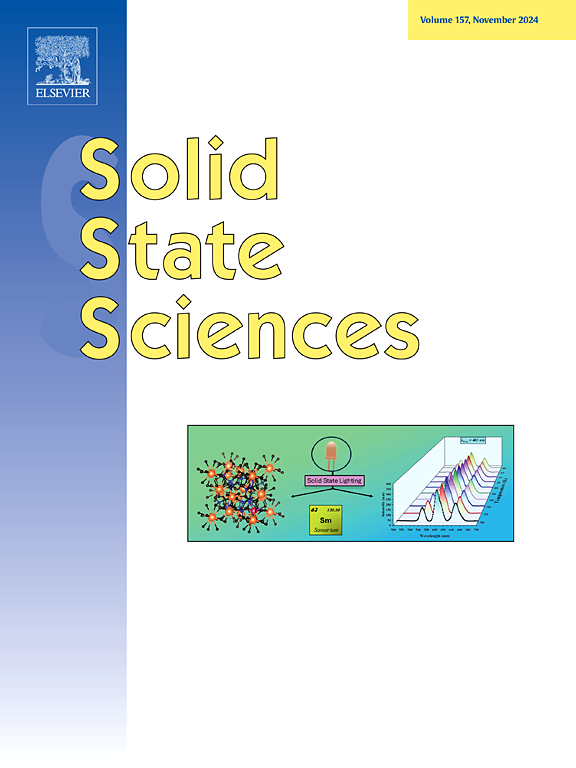液晶大环配体-钴(III)配合物的应用前景
IF 3.3
3区 化学
Q2 CHEMISTRY, INORGANIC & NUCLEAR
引用次数: 0
摘要
热稳定的大环过渡金属液晶(metalomesogens)因其卓越的性能和在各个科学领域的潜在应用而引起了人们的关注。这些具有热致转变的自组织液晶是极好的合金材料,其中过渡金属的功能特性,如磁准则、电荷传导能力、氧化还原或发光特性与大环的多孔结构和广泛的表面积相结合。这种关联导致形成了在各种智能电子设备中具有应用前景的物质,从光学显示器到药物输送,以及能量存储和转换系统。本文介绍了钴基大环金属合成源[Co(Clm)(Dec)2]的合成、结构分析和热、介晶特性评价。式中,Clm表示环环(1,4,8,11-四氮杂环十四烷),Dec表示4-癸氧基苯甲酸酯(4- ch3 (CH2)9OC6H4COO-)。虽然单晶x射线衍射由于晶体生长方面的挑战而失败,但通过元素检测、紫外-可见吸收光谱、傅里叶变换红外光谱、室温磁化率测量和热重分析(TG),推导出了扭曲八面体的反式III Co(III)离子的配位几何。室温磁化率发现磁矩为0.60 BM。八面体结构中抗磁性低自旋Co(III)的特征。热重分析发现其具有良好的热稳定性,在229℃时开始崩解。通过DSC检测了相的转变,并用偏光显微镜研究了具有代表性的光学织构;这显示出在近晶中间阶段典型的板条织构的生长。本文章由计算机程序翻译,如有差异,请以英文原文为准。

Macrocyclic ligand - cobalt (III) complex of liquid crystal for future applications
Thermally stable macrocyclic transition metal containing liquid crystals (metallomesogens) have garnered attention for their remarkable properties and potential applications across diverse scientific domains. These self-organizing liquid crystals with thermotropic transitions are excellent mtallomesogens where functional properties of the transition metals such as magnetic criteria, charge conduction ability, redox, or luminous property are combined with the porous structure and wide-ranging surface area of macrocycles. This association leads to the formation of substances with promising applications across various smart electronic devices, spanning from optical displays, to drug delivery, and energy storage and conversion systems. This study presents the synthesis, structural analysis, and evaluation of thermal and mesomorphic characteristics of a cobalt-based macrocyclic metallomesogen, [Co(Clm)(Dec)2].(Dec); where Clm denotes cyclam (1,4,8,11-tetraazacyclotetradecane) and Dec represents 4–decyloxybenzoate (4-CH3(CH2)9OC6H4COO-). Although single-crystal X-ray diffraction was unsuccessful due to challenges in crystal growth, the coordination geometry of the trans-III Co(III) ion that was distorted octahedral was deduced through elemental examination, spectra obtained from UV–visible range absorption, Fourier-transform infrared (FTIR) spectroscopy, magnetic susceptibility measurements at ambient temperature, and thermogravimetric analysis (TG). The ambient temperature magnetic susceptibility discovered a magnetic moment of 0.60 BM., distinctive of diamagnetic low spin Co(III) in octahedral geometry. Thermal analysis by TG found good thermal stability, with disintegration initiated at 229 °C. Transitions of phase were perceived through DSC, and the representative optical textures were investigated by means of POM (Polarizing Optical Microscope); that exhibited growth of battonet textures typical for smectic mesophase.
求助全文
通过发布文献求助,成功后即可免费获取论文全文。
去求助
来源期刊

Solid State Sciences
化学-无机化学与核化学
CiteScore
6.60
自引率
2.90%
发文量
214
审稿时长
27 days
期刊介绍:
Solid State Sciences is the journal for researchers from the broad solid state chemistry and physics community. It publishes key articles on all aspects of solid state synthesis, structure-property relationships, theory and functionalities, in relation with experiments.
Key topics for stand-alone papers and special issues:
-Novel ways of synthesis, inorganic functional materials, including porous and glassy materials, hybrid organic-inorganic compounds and nanomaterials
-Physical properties, emphasizing but not limited to the electrical, magnetical and optical features
-Materials related to information technology and energy and environmental sciences.
The journal publishes feature articles from experts in the field upon invitation.
Solid State Sciences - your gateway to energy-related materials.
 求助内容:
求助内容: 应助结果提醒方式:
应助结果提醒方式:


